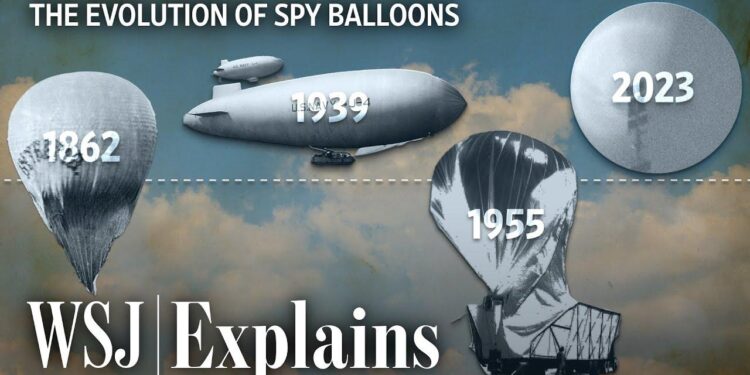As nations extend their reach beyond traditional battlefields, the race for dominance in the stratosphere has taken a new turn. France is now preparing to deploy advanced spy balloons designed to gather critical intelligence high above the clouds. This strategic move underscores the growing importance of aerial surveillance technologies in modern defense, marking a pivotal moment in the emerging contest for control over the skies. In this article, we explore France’s latest developments in stratospheric reconnaissance and what they signal for the future of military intelligence.
France Advances High-Altitude Surveillance with Next-Generation Spy Balloons
France is accelerating its push into stratospheric intelligence-gathering with the deployment of state-of-the-art surveillance balloons designed to operate at altitudes exceeding 20 kilometers. These next-generation platforms, equipped with cutting-edge sensors and AI-driven data processing capabilities, provide persistent monitoring of conflict zones, maritime routes, and critical infrastructure from the edge of space. Unlike traditional satellites, these balloons offer greater flexibility in repositioning and lower costs, allowing rapid response to emerging threats and dynamic intelligence requirements. Defense officials emphasize the strategic advantage of maintaining a constant, high-altitude vantage point amid growing geopolitical tensions.
Key features setting these spy balloons apart include:
- Adaptive flight control: autonomous station keeping to maintain optimal surveillance windows
- Multi-spectral imaging: capturing data across visible, infrared, and radar bands
- Secure real-time communications: encrypted links for instant intelligence relay
- Solar-powered endurance: enabling months-long missions without ground intervention
The initiative positions France alongside leading global powers engaged in the so-called stratosphere arms race, where dominance over the atmospheric frontier is viewed as the next step in modern warfare and reconnaissance.
| Feature | Capability | Benefit |
|---|---|---|
| Altitude Range | 20-25 km | Extended line of sight for wide-area coverage |
| Surveillance Sensors | Multi-spectral (Optical, IR, Radar) | Comprehensive environmental and tactical data |
| Flight Duration | Up to 6 months | Persistent reconnaissance without frequent redeployment |
| Communication | Encrypted Satellite Link | Secure, real-time data transmission |
Strategic Implications of Stratospheric Monitoring in Global Security Dynamics
As governments escalate their investment in stratospheric technologies, the battlefield is no longer confined to terrestrial domains or even low Earth orbit. France’s recent deployment of advanced spy balloons signals a strategic pivot towards exploiting the upper atmosphere for intelligence gathering and real-time surveillance. These platforms offer a low-cost, persistent vantage point, enabling unprecedented coverage of contested regions without the diplomatic complications of traditional aerial reconnaissance. The shift underscores how control and monitoring of the stratosphere is becoming a critical component for national security, influencing geopolitical tension and alliance formations worldwide.
Key strategic advantages of stratospheric monitoring include:
- Extended operational endurance compared to satellites.
- Rapid redeployment capabilities over flashpoint areas.
- Low detectability and enhanced stealth features.
- Real-time data transmission for dynamic battlefield awareness.
| Country | Stratospheric Assets | Primary Use | Estimated Deployment Timeline |
|---|---|---|---|
| France | Spy Balloons | Intelligence & Recon | 2024 Q3 |
| USA | High-Altitude Drones | Surveillance & Communications | 2023 Ongoing |
| China | Stratospheric UAVs | Monitoring & Electronic Warfare | 2025 Planned |
Expert Recommendations for Enhancing Balloon-Based Intelligence Capabilities
To significantly advance the capabilities of balloon-based intelligence platforms, experts emphasize the integration of cutting-edge sensor technologies and AI-driven analytics. Deploying high-resolution multispectral cameras alongside sophisticated signal interceptors can dramatically expand surveillance scope and data fidelity. Moreover, integrating real-time machine learning algorithms enables autonomous target recognition and rapid data dissemination, crucial for operational success in contested airspace. Enhancements in balloon materials are also recommended, with a focus on lightweight composites that improve altitude endurance while minimizing radar signature.
Strategic operational frameworks suggest a multi-layered deployment model to maximize coverage and resilience. Experts advocate for coordinated balloon swarms equipped with complementary sensor suites, working in tandem to cross-verify intelligence and mitigate single-point failures. The table below outlines key recommendations, highlighting their potential impact on intelligence collection and mission reliability:
| Recommendation | Expected Benefit | Implementation Challenge |
|---|---|---|
| AI-Enabled Autonomous Analysis | Faster target identification | Algorithm training complexity |
| Composite Ultra-light Materials | Extended flight duration | Cost & manufacturing scalability |
| Multi-Balloon Swarm Deployments | Enhanced data cross-validation | Communication network robustness |
| Multispectral Sensor Integration | Broadened surveillance spectrum | Data processing bandwidth |
Concluding Remarks
As nations vie for dominance in the increasingly contested stratosphere, France’s development of sophisticated spy balloons underscores the evolving nature of aerial surveillance and defense. Positioned between traditional satellites and lower-altitude drones, these high-altitude platforms offer a strategic vantage point in the emerging arms race above the clouds. As technological advancements accelerate, the international community will be watching closely to see how France’s initiatives influence both military capabilities and geopolitical dynamics in this new frontier.
















